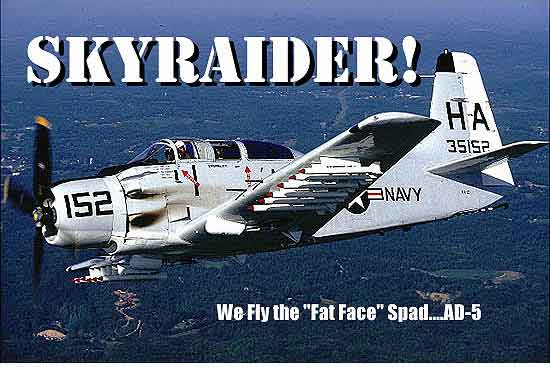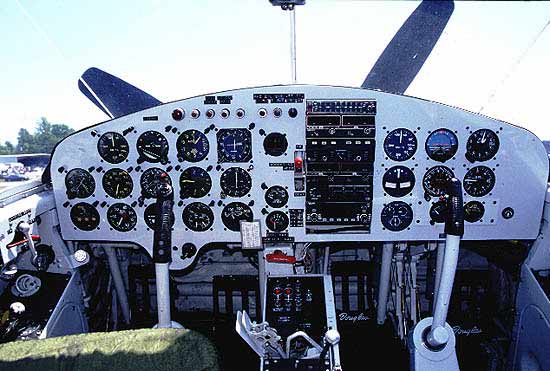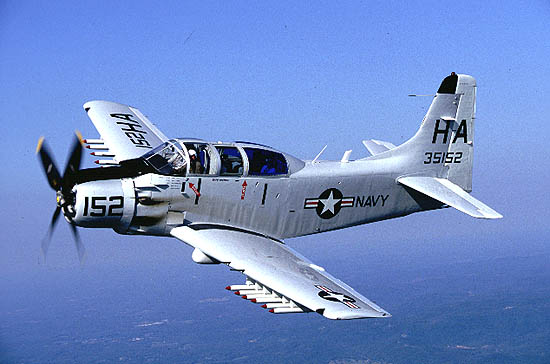Sie sind nicht angemeldet.
Lieber Besucher, herzlich willkommen bei: . Falls dies Ihr erster Besuch auf dieser Seite ist, lesen Sie sich bitte die Hilfe durch. Dort wird Ihnen die Bedienung dieser Seite näher erläutert. Darüber hinaus sollten Sie sich registrieren, um alle Funktionen dieser Seite nutzen zu können. Benutzen Sie das Registrierungsformular, um sich zu registrieren oder informieren Sie sich ausführlich über den Registrierungsvorgang. Falls Sie sich bereits zu einem früheren Zeitpunkt registriert haben, können Sie sich hier anmelden.



Zitat
When I first strapped into Hank's Skyraider I was struck by a number of unusual impressions all at the same time. As I dropped into the seat, I couldn't believe the visibility. Most WWII vintage airplanes, Stearman to Mustang, share at least one common characteristic. You can't see squat over the nose. During takeoff and landing, your world is defined by the sides of the runway visible around the nose. Not so in the Skyraider. Here the nose is a sizable amount below your line of vision. You're sitting so high that, despite the huge cockpit, it is as if you're sitting "on" the airplane, not "in" it.
The cockpit is much wider than most twin engine airplanes. In fact, it's possible a yardstick would find it nearly as wide as a B-25, but the bubble type canopy imparts an almost "airy" feeling to it.
The control stick is just a little unusual, if nothing else because it pivots for pitch at the bottom but pivots for roll about half way up. This is exactly the same as a Spitfire and you don't even notice it once the engine is running. The rest of the cockpit is strangely simple compared to it's WWII counter parts thanks to automatic servos in some of its systems.
With the cost of an overhaul on an R-3350 approaching that of a small North Carolina house, starting the engine isn't a casual affair. Every effort is made to avoid hydraulic locks due to oil in the cylinders or bearing damage due to the oil running down off bearing surfaces while the airplane is inactive .
Area clear. Master on. Mags off. Mixture auto cut-off.
Hit pre-oiler to force oil into bearings before turning the engine over.Yell "clear." Engage starter, count eight blades. Stop cranking.
Hit pre-oiler again. While this is happening high pressure oil is making certain all the engine bearings are liberally bathed in oil.
Engage starter and count sixteen blades, four revolutions, to clear cylinder of oil. The bottom cylinders of a radial, especially Wrights, love to collect oil, while sitting. Fire it up with oil in a cylinder and the compression ratio goes to a billion to one and a rod is bent. It's a very expensive noise.
Now the engine is oiled, cleared and ready to start. Aux Hydraulic boost is checked, to make sure it's working in case the primary system isn't.
Fuel boost on, crank another eight blades. Primer button down. Keep cranking. Reach up with a free hand and flick the mag switches to "both."
At this point a series of hollow coughs belch intermittent clouds of blue smoke past us. The smell of a radial engine permeates the cockpit. Eau de Roundmotor. Nothing smells like it.
In seconds the coughs blend together. The primer button is held down until it's running and the mixture control next to the throttle is shoved forward to rich.
Check oil pressure. Hydraulic pressure Everything else coming up.
A living breathing horsepower factory is now sitting just in front of our feet.
I leave my side of the canopy open and breath in a little wonderfully fragrant toxic waste.
The R-3350, by the way has an unusual sound to it. It has a vaguely "mechanical" undertone that at idle almost overpowers exhaust noise. It's probably the gears in the reduction unit whirling away, but it initially sounds a little like a piece of farm equipment.
We leave the wings folded while maneuvering out towards the open area near the taxiway. It would be bad form to unfold the wings and hammer a Cessna flat.
The Navy has a thing about accidental wing folding, as evidenced by their folding controls. While the wings are folded, a large, flat door in the middle of the console between the seats is open and the cover pokes the pilot in the leg reminding him not to takeoff with the wings folded. Duh!. To close the door requires pushing and turning a control handle in a well on the console. If it isn't in the right place, you can't close the door.
As the wings slowly drop into place, a red bar about as big around as your thumb which has been sticking out of the leading edge is retracted flush indicating the wing pins have slid into place. I check to see if the console door closes flush. I check the red pin again. Looks okay. Still....
The Skyraider, as with most taildragging carrier aircraft, has a locking, full swivel tailwheel. When the control on the left console behind the throttle is engaged, the tailwheel is locked straight forward which supposedly makes the airplane track straight. It doesn't. The airplane will still wander. If it's unlocked, the tailwheel swivels and you have to stay right on top of it with brakes.
Although the airplane was easy to taxi, I was surprised how often I had to tap a brake to keep it from turning into the crosswind. I should have made better mental note of that characteristic.
At the end of the runway, we did a Q and A type of check list. I'd hold it up and call out the item and Doc would confirm it in place.
- Wings down and locked? Check!
- Aux Hydraulic pump, off? Check!
- Boost pump, on? Check!
We ran down down the list including making certain the trim was where it had to be: 1 1/2 units right rudder, zero elevator for this load, and balanced ailerons as per the last time the airplane flew.
We held the last two items, the tailwheel lock and mag check, until out on the runway and powered up ready to launch. It's recommended that power be brought up to field barometric pressure, about 30 inches, just prior to takeoff to clear the plugs. The mags are checked at the same time.
One of my eternal impressions of that first takeoff was that, for some reason, the airplane just seemed "light." I can't explain that. It didn't hunker down on the gear like a Mustang or Bearcat, which don't change character until the power and speed are well up. As soon as the power was up on the Skyraider and we were accelerating, I could feel the airplane getting light, the oleos coming off the stops. Of course we probably didn't weigh more than 15,000 pounds (!!) so we really were light.
As soon as the runway started to fall away, I saw the safety catch on the landing gear handle magically disappearing into the cockpit rail, letting the gear handle be moved into the up position.
As soon as we were going uphill solidly, I made the first recommended power reduction to 38 inches. Then, as the gear locked up, the power came back to 35 inches, the prop at 2600 rpm, where it stayed while we climbed up stairs.
I didn't think too much about it at the time, but since the engine was designed to run on 130/145 octane fuel, with an alternate of 100/130, there was no way with only 100LL fuel available we could have reached the normal takeoff power of 56-58 inches without detonation setting in. As it was, we were using only 45 inches for takeoff where the military recommended 48 inches just for climb. Lower power settings may be partially because of fuel limitations, but also because there's no reason to push an engine you actually own. None of us are 22 years old and burning up Uncle Sam's motor and fuel.
Like I said before, I was just faking the role, not living it. At 58 inches, the Skyraider must be a real hoss on takeoff.
We ran upstairs at 1800-2,000 fpm at 120 knots indicated. Spad pilots have told me when fully loaded, they were happy to get even half that.
As soon as the airplane was off the runway, I knew I liked it. The ailerons especially. Although they have conventional cables running to them, the controls are hydraulically boosted with the boost being perfectly balanced. The result is a set of slick controls that on all axis are on a par with, and actually better, meaning lighter and quicker, than, most prop fighters. Despite its huge size, the airplane is absolutely willing to dance.
Motoring along above a broken cloud deck, the green of North Carolina peeking through and sufficing for Viet Nam, I realized I may have been looking at similar scenery, but it had to look different knowing "they" were down there. It had to be different when at any time 37 mm AAA could be bursting around you. Still, it was a golden opportunity and I again silently thanked Hank Avery.
All Navy airplanes have great slow speed characteristics and I was curious about the Skyraider's. The power came back and I set it up for a clean stall, not expecting even remotely what I got. Here we were, weighing half of what a small town weighs, but the airspeed kept winding down until at about 90 knots, the stick started tickling me. Then, as the speed kept going down, the airframe was buffeting harder until, just before the stall broke, it was hammering my brains out. Talk about stall warning! You'd have to be asleep to miss it.
Gear and flaps down, the final stall was down around 70-75 knots, with a slight break and left roll, but the buffet was still just as pronounced. I held it deep into the stall, then, all it took was releasing back pressure for it to start flying again. Cessna's don't stall any better than this! In fact, they don't give that much warning.
Dropping the nose to head back to the field, I was again brought up short: Nose down, it doesn't want to pick up speed anything like I expected. In fact, I had to really crank the nose down trim into it to hold it down long enough to touch even 200 knots. With the speed brakes out and full ordnance, pilots doing the real thing must have been able to come in at terrific angles and still make the pull out.
We were using 100 knots as a target speed in the pattern on downwind, which surprisingly enough, the airplane was perfectly willing to decelerate to by just reducing the power. I didn't have to yank it into a bank or do anything drastic to get it slow.
My intent was to hold 1,000 feet and 100 knots. We'd been cruising around at altitude at about 28 inches of manifold pressure. It was taking less than 20 inches to hold 100 knots. Then I threw the gear and flaps out and everything changed. The throttle went up. And up. And then up some more until I was back at 28 inches. This thing is dirty!
Doc ran through the pre-landing check list, told me he wanted 90 knots over the fence and to slowly de-accelerate all the way down to that number. At the time I thought, yeah right! Just slowly de-accelerate and hold glide slope.
I wasn't half way through base leg when I realized I wasn't even beginning to work to hold speed. If I wanted 95 knots, it would sit at 95 knots. If I wanted 92 knots, that's what it would hold.
The power was gradually coming back, as I worked my way down final trying to keep the runway numbers stationary in the windscreen. If they were moving up, I was going to be short. Moving down, I'd be long. At the bottom end of the throttle travel, it turned out there was really very little movement required to change glide slope. It was more of a pressure and the perceived engine noise hardly changed at all.
A little high. Pressure the throttle back. Coming back on glide slope, pressure it forward. Just follow the runway numbers with the throttle.
Then the runway was right there and the game was over. I was going to have to land this thing! This would be the heaviest tailwheel airplane I'd ever landed. I sneaked a quick peak at the windsock. I shouldn't have and didn't need to to know the wind was there. I was already one wing down and holding opposite rudder to keep the nose aligned with the centerline.
In situations like that, it's just going to be what it's going to be. Deal with it. Cardinal rules of landing tailwheel airplanes: Keep the nose in front of you: keep the airplane from drifting: hold three point attitude. If you do all of those, gravity has a way of solving everything else.
As I started to break the glide, I slowly began squeezing the throttle closed. I was talking to my right hand on the stick. I was telling it to get into three point just as the runway came up. There the attitude is! Hold it off, hold it! Oops, slight rudder needed. Keep it straight. Hold it off, hold it...thunk! We touched down. On all three yet! And with no bounce!
Something about even a blind pig finding an acorn once in a while fits here.
Okay, I was down. Keep it straight. Eyes fixated on the centerline. Feet connected to the eyes. A little left rudder. A little right. Brakes. More Brakes. We coast to a halt. Alright! Cheated death one more time!
As I tried to decide which taxiway turnoff to take, an Aztec pilot behind me on short final said, "How about it Skyraider. You going to clear the runway anytime soon?"
One smart comment deserves another.
I said, "That was my first Skyraider landing. Gimme a break. How was your first one?"




Forensoftware: Burning Board® 3.0.24, entwickelt von WoltLab® GmbH
